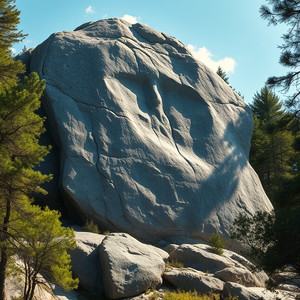Zuma Rock: Nigeria’s Sacred Giant Landmark

Zuma Rock stands tall, a symbol of Nigeria’s strength and history. Witness the power in every stone! This image was digitally created.
Nigerian Zuma Rock: Secrets of the Iconic Landmark You Never Knew
Let’s be real with each other: if you’ve been cruising along Nigeria’s northern roads, particularly the Abuja-Kaduna highway, and somehow missed Zuma Rock, then maybe you’re not paying attention.
This thing is huge. It’s one of the most striking landmarks in Nigeria.
Nope, this is no ordinary rock; it is Zuma Rock. This is a granite monolith otherwise known as the “Gateway to Abuja,” which silently appears to watch over the country.
But wait a minute, what do we really know about it aside from those tourist pictures? Fasten your seat belts, as the story of Zuma Rock is more than just a tale of how it was formed-it’s a mixture of cultural and spiritual, even historical intrigue.
Let’s reveal to you some mysteries of Zuma Rock that you probably have not heard.
The Legend That Looms Over Nigeria
Before even beginning to talk about the geology of Zuma Rock, let’s first discuss what makes this landmark stand out from the crowd of rocks you may have seen around the world.
First off, Zuma Rock isn’t just another big stone; it’s a part of Nigerian culture. No exaggeration.
This rock has a very deep cultural history, tracing back to hundreds of years. This rock was named “Zumwa” by the Zuba people, meaning “the place of catching guineafowls.” According to the generations who lived in this region, it was so named.
Why would such a name exist? The reasons are birds dwelling around the structure. That indeed might be inconsequential, but this was just a chip off a very large and bigger structure of a relationship the people had with the rock massif.
The meaning of this rock does not simply start or end with a name given. Zuma Rock has, over time, become integrated with religious activities among others in this community.
Yes, it is said to have been a sacred place among the native people. The Gwari people-who were the indigenous tribe of the land-have it in regard as a rock representing strength and survival.
With time, this has become a big figure in the folklore of Nigeria. The rock is believed to possess protective powers, which is not just a narration but is deeply engraved into the people; it is passed from generation to generation through stories narrated by the elders sitting around the fire at night.
This rock isn’t just a geological formation; it’s a living monument to Nigeria’s history, culture, and those unseen forces that shape the identity of a community.
Long before colonial times, Zuma Rock was a highly significant feature. Now that’s one heck of a legacy for any stone.
And Just When You Thought It Couldn’t Get More Interesting…
Well, here is where it gets interesting. Most of the people who take selfies just in front of Zuma Rock may not actually know one of the more intriguing features of this place-the face.
Yeah, Zuma Rock does appear to have a face, even human-like. In one direction or another, you actually could make out some giant face staring at you.
Some people think it’s just a trick of the light; others think this face was deliberately shaped by nature in the formation of the rock.
Anyway, it is an added layer of mystery to an already fascinating landmark. Think about it: how many rocks do you know with a face?
Seriously, take a moment and think about it.
Over the years, travelers and adventurers have marveled at how strikingly human the face looks. Many believe the face signifies power and protection.
Whether you’re a skeptic or a believer, it definitely gives off an otherworldly vibe. And the face isn’t just for show — it’s also deeply tied to local folklore.
Some people believe this is a sign of the spirits of their ancestors, looking out for them; others believe it was put there to ward off any person or people with malice in their heart.
If you ever plan on getting personal with Zuma Rock, beware. That face? Not something to be trifled with.
Geologically Speaking — This Rock Is No Joke
Okay, now to the scientific part of the story, because this rock wasn’t just placed here at random. Zuma Rock is a kind of granite monolith-a rock that is all solid and crystallized, and which has formed over many years.
This is not some freak incident. This rock has been with us for so long, maybe 500 million years. It was produced during a very violent volcanic eruption and the ensuing erosion that followed.
This is a very hard rock, for which reason it has resisted the forces of weathering for all these centuries in the African landscape.
Zuma Rock rises to 300 meters, almost 1,000 feet into the air. You can practically feel the ancient energy pulsating from it as you draw closer to it.
You are looking at something that has been in existence long before humans ever came onto the scene. As a matter of fact, this rock is older than most of human history. If that impresses you, wait until you hear this: the rock is surrounded by a rich array of plants and wildlife; the area is an important hub of biodiversity.
The Gwari people have farmed the surrounding land, used it for ceremonies and rituals, weaving into a rich array of cultural practice. The immediate environment is no less iconic as the rock itself-a marriage of nature and history.
Zuma Rock in the Modern Day
Now let’s zoom into the present day — Zuma Rock is not just some historical relic. It’s also a key symbol in modern Nigeria.
It has been adopted as the official symbol of Abuja, the nation’s capital. Driving into Abuja from Suleja, Zuma Rock rises like a sentinel to your entry into the city.
Let’s get real now-this is not just any ordinary rock. It is a reflection of strength, resilience, and protection.
But that is not all, as its proximity to Abuja makes Zuma Rock one of the important features concerning Nigeria’s tourism industry. Abuja, with the mix of urban life and cultural importance, provides just the perfect contrast to the natural beauty of Zuma Rock.
Zuma Rock has become a tourist hub for both domestic and foreign tourists in recent times. And no, it is not just about that perfect Instagram shot-took, though that definitely is part of it.
People come because they are genuinely interested in the history and power behind the rock. The most popular activities include hiking, photography, and birdwatching.
There is a kind of peace that surrounds one, closer to Zuma Rock. You feel small-standing in front of it-but in a rather humble way.
It’s like being in front of something that was there long, long before anything you can even imagine. That feeling of history, that feeling of century-spanning stories, doesn’t go away so easily.
The Gwari Connection: More Than Meets the Eye
To the people of Gwari, Zuma Rock is not only a part of the geography but also something spiritual. The Zuma Rock to them means something more than just a piece of nature.
It’s a spiritual cornerstone. Generations have passed, and the Gwari people have been living around Zuma Rock; their lives entwined with its presence.
As told by the local traditions, it houses ancestral spirits, and whoever approaches it respectfully is showered with blessings.
To them, it’s not a place, it’s a living part of their identity.
But more than this, beyond spirituality, Zuma Rock is also a symbol of resilience to the Gwari people amidst an area that has really had its fair share of instability and challenges, Zuma Rock remains unshaken.
It’s a constant reminder of the strength that can be found in the face of adversity. If this rock can stand tall for so many centuries, then surely the people can too.
Visiting Zuma Rock: More Than Just a Selfie
If you’re planning on visiting Zuma Rock, here’s a tip: Don’t just come, take a picture, and leave.
Take time to appreciate the place: take a walk around the base, sit in the shade of its huge form.
Listen to what the locals say about its history and its importance. Take a walk along the trails that are nearby.
Most of all, respect the cultural significance this place has for the people around it. Zuma Rock may be a major tourist attraction, but it’s still a deeply sacred site for those who live nearby.
It is not a place for superficial tourism but a site for contemplation of the strength of history and culture.
Conclusion: Why Zuma Rock Matters Even to This Day
Zuma Rock is way more than just a large rock formation; it’s a living monument to the history, culture, and spirit of Nigeria.
It is not a place that people would just pass through on their way to Abuja; it is a place that tells the story of resilience, protection, and strength.
To the people of Nigeria, especially the Gwari, Zuma Rock is in their soul. It’s a reminder of how powerful the land can be and how it has shaped the people who call it home.
If you haven’t been to Zuma Rock yet, probably it’s about time you went. More is to be seen than its colossal size.
There is a story in every stone, a history in every crack. And then there is Zuma Rock, which, far from being a simple landmark, is actually a passageway into the very heart of Nigeria, simply waiting to be seen.






